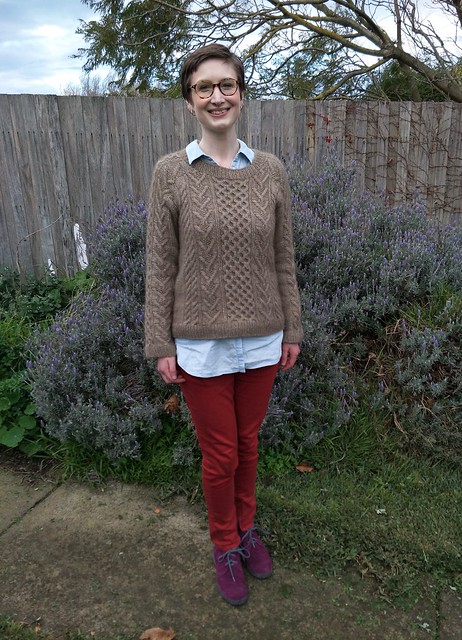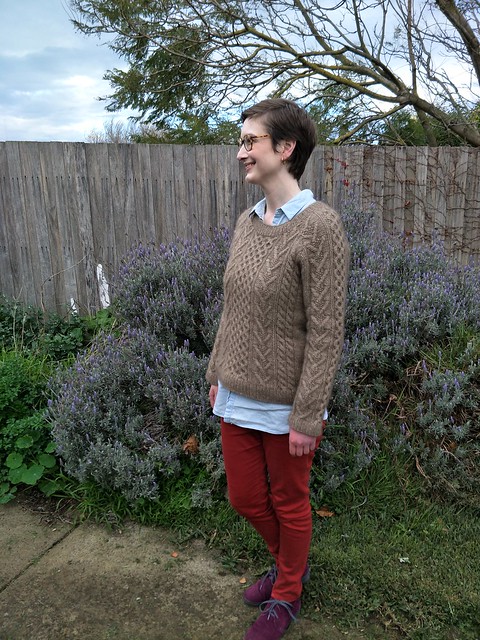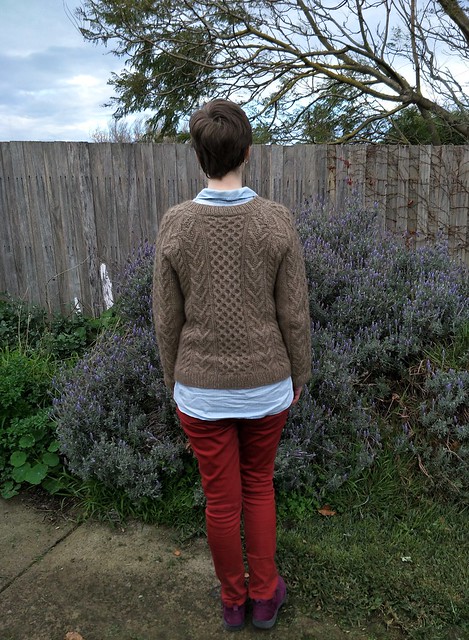Last I wrote about my Bronwyn jumper, it was destined for the frog pond. With so many issues I couldn’t face ripping and reknitting the sleeves yet again, nor doing the calculations to make them fit the seamed yoke shaping, particularly not in a complex cable pattern. It took some time away for me to realise I couldn’t give up that close to finishing, so I put on my patternmaker hat, finished the sleeve maths and then the jumper itself, an exact year after casting on.
Most of my problems stemmed from the fact that this pattern was bottom-up and seamed. I really prefer working with seamless top-down patterns as they allow you to fit as you go, and tried to convert this pattern to top-down several times with no avail. I begrudgingly worked this from the bottom-up, but as I needed to change the pattern calculations as my gauge was different to the pattern, I found myself getting stuck on the sleeve shaping over and over again.
Not only was my gauge off, but the sleeves as written were so narrow as to restrict movement, at least in my chosen yarn. It was only after knitting and reknitting them 2-3 times that I found a size that suited and raglan shaping that worked with the existing neckline (that I had also reworked to fit the gauge and have a deeper underarm). The neck was still a little wide as drafted to I knitted an extra-long neckband (1.5″) to fill it in. Stylistically, I omitted the uneven split hem just so this garment will last longer in my wardrobe than that particular fashion.
My other issue (too short a body) was resolved in the blocking. Being superwash yarn, the jumper stretched lengthwise in the wash and I helped it out a little when drying to shape. Unfortunately the sleeves stretched out too – something I didn’t need!*
I’m glad I took the time to finish this garment as the end result is just beautiful. The cables are lovely to look at and texturally satisfying, and the possum-merino yarn itself is a soft, fluffy delight. If you weren’t aware, brushtail possums are native to Australia but a feral species in New Zealand, and culling them for yarn is part of sustainability efforts to preserve native flora and fauna.
The Zealana Rimu yarn has all the softness and springiness of merino wool with a fluffy halo almost like that of mohair, but with less defined strands. Possum is also an excellent insulator and far lighter than wool, so this jumper weighs a lot less than you’d expect. It was a luxurious knitting experience and I look forward to knitting with possum again, perhaps in their 80/20 merino/possum blend Heron. I’m not a big fan of expensive yarns but this is worth it in my opinion.
What I won’t be knitting again is a seamed, bottom-up jumper. The whole process is so frustrating for me that it takes the joy out of knitting, and why knit something that isn’t fun? It even shits me that the sleeves are a little too long and I can’t just frog back and fix them.** I’ll get some wear out of this jumper, but my next project will most certainly be top-down!
Edit 18/07/18: I reknit the neckband on this jumper to bring it in a little. Read more here!
The deets:
Pattern: Bronwyn by Melissa Wehrle (my Ravelry notes)
Pattern details: “Traditional Aran elements get a contemporary lift from a vented hi-lo hem with double-deep ribbing at the back. Bronwyn is chock full of knitterly details: circular construction gives way to a seamed raglan yoke for added structure, tubular ribbing ensures durability and elasticity at the edges, and the cable motifs are thoughtfully aligned to help you memorize the pattern and avoid miscrosses. The fit is slightly oversized with a straight torso balanced by narrow sleeves; choose a size that will allow for movement over your hips.” Available from Wool People Vol. 10.
Yarn: 1331.2m Zealana Performa Rimu DK in Natural.
Needles: 3.75mm for tubular cast on foundation rows, 4mm for ribbing, 4.5mm for rest.
Mods: Different gauge (16.5 sts & 25.5 rows / 4” in stockinette) with altered stitch count.
– Worked body in one piece (no split hem) for a total body depth of 24” from back neck
– Stockinette panels between cable charts
– Slightly deeper yoke with own raglan shaping to match neck st count and new sleeve shaping
– Wider sleeves (about 9-10” width in wrist and 13+“ in bicep)
– Used long tail CO (knits) and twisted German CO (purls) for sleeve and regular cast off for neckband as tubular stretched out too quickly
– 1.5″ long neckband (more details in Ravelry notes)
*Clara Parkes explains why in her excellent Knitter’s Book of Yarn: “Perhaps the most important drawback of the superwash process, however, has to do with stretching. Since the fibers lack the scales that normally help hold everything together, some superwash wools can stretch dramatically with washing. (And because it’s superwash, you can’t just toss it in the washing machine to shrink it.) Your best course of action is to buy a single skein of yarn and knit a sizable swatch with it. Wash the swatch and let it hang dry. Hanging handknits is normally a no-no, but in this case we want to induce stretching to see just how far it goes.”
**If this was plain stockinette I could snip a thread just above where I wanted the new ribbing to begin on the sleeve, painstakingly pull back and knit in the opposite direction to which the garment was originally created. But as this is patterned, the demarcation line between the opposing directions of knitting would be painfully obvious (the 1/2 st offset becomes indistinguishable in stockinette, almost like a visual illusion).






Lovely, and looks very cosy! Tbh, I don’t see why you think the sleeves are too long, to me they’re perfect. Warm and wintry sweater, warm and wintry sleeve length. I love having my wrists covered in the cold months. But, if you really really want to shorten the sleeves, why not snip where you’d like the ribbing to start, unravel to the top of the ribbing on the snipped off part and mask seam* the ribbing back on?
*Not sure what you’d call the technique, so this is what I’d call it in Norwegian.
LikeLiked by 1 person
Btw, regarding knitting bottom up or top down – would a cable pattern look as good top down? I imagine not, as they seem to have a very clear direction, but I might be wrong. Have you made any top down cabled sweaters you can share, with close. Up photos?
LikeLiked by 1 person
I think you’d call that grafting or kitchener stitch. It’s something I considered but I had read that grafting ribbing is problematic due to the stitch offset, but now I realise I was reading about grafting two bits of ribbing which were knit in the opposite direction, and of course it would work with my sleeve! Thanks for the idea.
Cables looks just fine top down, so long as the chart itself is top-down. I reversed this cable chart when attempting a top down version and it looks basically identical to the finished, bottom up garment. I did a Ravelry search for top down cabled garments and lots came up: https://www.ravelry.com/patterns/search?query=#craft=knitting&view=captioned_thumbs&pa=cables%2Btop-down&pc=sweater&sort=popularity
Chuck by Andi Satterlund is one I have made personally but don’t have any close up photos of it, lots of people on Ravelry do though.
LikeLike
Thanks! Off to Ravelry…
LikeLiked by 1 person
And in regards to the length, it doesn’t get *that* cold here – certainly not below 0C, 10C would be considered a freezing winter’s day. I prefer sleeves that don’t get wet, so I usually stop mine just above the wrist.
LikeLike
This sweater is GORGEOUS! And honestly at the rate I knit (and frog) things, 1 year is fast to finish! I do think it’s interesting that you prefer top down for fitting – I find that harder. I like bottom up in the round as I can tell pretty quickly how it will fit around my body. I knit my sleeves in the round two at a time, too, but that really is a pain.
LikeLiked by 1 person
Thanks Meg. I find bottom up hard to fit in that way as my tum/hips are the largest part of me and it can be hard to gauge an accurate fit without knowing exactly where the hem will sit on me. Whereas with top down, once you nail the shoulder fit it’s just a matter of increasing as needed.
Agreed on the sleeves! And my gauge always goes off in small circumferences in the round, so my sleeve calculations never turn out quite right if I’m casting on from the smallest part.
LikeLike
FWIW I think the jumper looks amazing. I love possum yarn (and can spot it at a thousand paces in the op shop:)) Have only knitted a scarf in it at this stage, but seriously thinking of a jumper. As you say, it is a dream to knit with.
LikeLiked by 1 person
Thanks, Sharron. I’m jealous you’ve found it in the op shop!! Definitely worth a jumper’s quantity if are able to purchase it.
LikeLike
Another stunning piece of knitting! You do such lovely work and everything you share just makes me want to knit all the things!! Well done for persevering with the sleeves, too; I can’t imagine the headache (literal and figurative) involved in all that calculating.
Speaking of sleeves, I am knitting a pattern by the same designer for my first-ever sweater and started with the sleeves (as a cheater gauge swatch, if you will). I thought I was imagining it when I noticed how small they seemed, but now I’m thinking it’s not just in my head after reading about your experience!
LikeLiked by 1 person
The sleeves were a nightmare! It is so much easier to calculate them in the round, top down. My head can only take so much 3D imaging of separate seamed pieces!
Regarding the sleeve width, did you compare what you’re getting to the schematic? I find if I’m starting with a small circumference in the round, my gauge is always sooooo much tighter than if I’d just worked top down, or worked a regular gauge swatch. But sleeves are very personal too, some designers definitely favour a tight fitted sleeve (or overall garment!) to what you might find comfortable, particularly over clothes. It’s worth considering that the actual knitted fabric takes up room when deciding on ease for a handknit garment, the thicker the yarn the more “room” it takes up and the more ease you require (IMO)
LikeLiked by 1 person
Yeah, my gauge is good versus the pattern, I guess I just expected them to look or be bigger somehow! (It’s my first time using anything heavier than a fingering weight, plus the sleeves are much slimmer versus the design ease of the body AND I’m using the smallest size.) You are quite right about the weight of the yarn taking up more space, too–definitely something for me to remember as I get more experienced!
LikeLiked by 1 person
Possums never looked so good–feral seems to suit you. This is absolutely exquisite! After this *challenge* I’m sure you could do anything–although this sensational jumper would be hard to top!
LikeLiked by 1 person
Perhaps I’m not too far from feral myself! Haha
LikeLike
The “Frog pond” 😁 Cracked me up! It’s a beautiful sweater!! Wishing it wasn’t so frustrating for you! Next one I’m sure will be/was better.
LikeLiked by 1 person
Thank you, I’m near finished the yoke on the next one and I’m pleased with it so far.
LikeLiked by 1 person